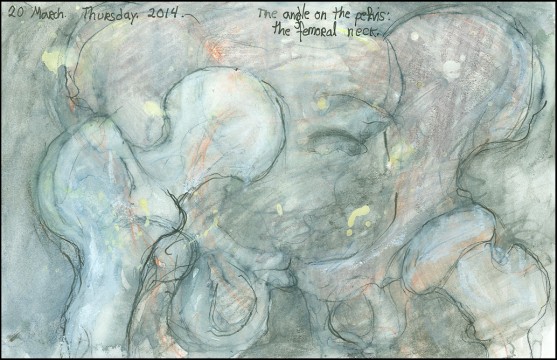Blog: DayBooks
Consider the femoral neck. Just suppose it’s not simply the end of the femur, as it perhaps appears at first glance. Until you get a relatively signigicant injury (and that’s not always a good way to come to enlightenment), it’s hard to sense out, suss out., or propriocept the femoral neck. It’s subtle angle, guarded by the greater and lesser trochanters, leads the femur into the acetabulum: leg and pelvis are united. The connection is stable and yet offers range of motion. Perfect balance. It’s a position that comes with a lot of pressure as well. When someone breaks a hip, it’s ofen the femoral neck that gives way.
The femoral neck lurks under the ASIS (Anterior superior iliac spine). And the ASIS is a big player in surface anatomy, it’s the anterior extremity of the iliac crest of the pelvis. It’s a little like a front porch. It definitely rates landmard status. It’s easy to locate the iliac crest and that’s should lead us to femoral neck: under-appreciated, often not noticed until it fractures in a fall. Better to strengthen it now with the dreaded standing poses. It’s worth a try anyway.
I have to keep rethinking the skeletal connections. My own sense of proprioception is far from natural or internalized. Some people seem to know by instinct where their center of gravity is. Not me. I go through a lot of mental (and sometimes diagramatic, hence these drawings) groundwork when I’m working on a yoga pose that requires reorientation or any sudden shift of position. I re-envision the parts of the pelvis and their juncture many times a day, and the shoulder girdle and then trace the spine (it’s easier when you can actually feel the bones.)
For me, that old song “the toe bone’s connected to your foot bone…” is a walking meditation. ( https://www.youtube.com/watch?v=mVoPG9HtYF8 ) And I always worry it’ll come out different some day.
This drawing is much more abstract than usual. But that seems appropriate.

